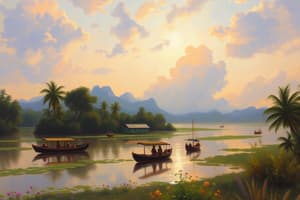Podcast
Questions and Answers
What primarily characterizes the national identity of the Filipino people?
What primarily characterizes the national identity of the Filipino people?
- The official language based on English
- The ethnic diversity of over 175 groups (correct)
- Influences from indigenous beliefs only
- A combination of Spanish and American cultures
Which of the following is NOT a major ethnolinguistic group in the Philippines?
Which of the following is NOT a major ethnolinguistic group in the Philippines?
- Ilocano
- Malay (correct)
- Tagalog
- Cebuano
What is a significant aspect of Filipino cuisine?
What is a significant aspect of Filipino cuisine?
- Dishes like adobo, sinigang, and lumpia (correct)
- Exclusively vegetarian dishes
- High reliance on dairy products
- Only traditional Spanish recipes
Which religion has the largest following in the Philippines?
Which religion has the largest following in the Philippines?
What describes the government structure of the Philippines?
What describes the government structure of the Philippines?
Flashcards are hidden until you start studying
Study Notes
Definition
- Filipino refers to the national identity of the people of the Philippines.
- It also signifies the official language of the Philippines, based on Tagalog.
Ethnic Composition
- The Philippines has over 175 ethnolinguistic groups.
- Major groups include Tagalog, Cebuano, Ilocano, Hiligaynon, Waray, and Kapampangan.
Language
- Filipino is the standardized form of Tagalog and serves as a lingua franca.
- English is also an official language and widely used in government and education.
Culture
- Rich blend of indigenous, Spanish, American, and Asian influences.
- Celebrations include fiestas, Christmas, and Holy Week.
- Cuisine features rice, seafood, and dishes like adobo, sinigang, and lumpia.
Religion
- Predominantly Roman Catholic, with a significant Muslim minority in Mindanao.
- Other religions include Protestantism, Buddhism, and indigenous beliefs.
History
- Colonized by Spain for over 300 years, followed by American control.
- Gained independence in 1946 after World War II.
Government
- Democratic republic with a president as the head of state and government.
- Divided into 17 regions, which are further subdivided into provinces, cities, municipalities, and barangays.
Economy
- Mixed economy with agriculture, manufacturing, mining, and services.
- Major exports include electronics, agricultural products, and textiles.
Arts and Literature
- Notable for traditional and contemporary art, music, dance, and literature.
- Influential literary figures include José Rizal, Nick Joaquin, and Lualhati Bautista.
Social Issues
- Challenges include poverty, inequality, and access to education and healthcare.
- Ongoing issues with corruption and political instability.
International Relations
- Active member of ASEAN, UN, and various international organizations.
- Focus on economic partnerships, security cooperation, and climate change initiatives.
Definition
- Filipino denotes both the national identity and the official language of the Philippines, rooted in Tagalog.
Ethnic Composition
- Over 175 ethnolinguistic groups exist in the Philippines.
- Major ethnic groups include Tagalog, Cebuano, Ilocano, Hiligaynon, Waray, and Kapampangan, each possessing unique cultural identities.
Language
- Filipino is a standardized dialect of Tagalog, functioning as a lingua franca across diverse regions.
- English serves as a second official language, prevalent in governmental affairs and educational settings.
Culture
- Philippine culture is a rich tapestry woven from indigenous, Spanish, American, and Asian influences.
- Major celebrations encompass local fiestas, Christmas, and Holy Week, reflecting a blend of religious and cultural traditions.
- Filipino cuisine prominently features rice and seafood, with iconic dishes such as adobo, sinigang, and lumpia highlighting local flavors.
Religion
- The Philippines is predominantly Roman Catholic, accounting for a significant majority of the population.
- Mindanao has a notable Muslim minority, alongside various other religions such as Protestantism, Buddhism, and indigenous beliefs.
History
- The archipelago was colonized by Spain for over 300 years, followed by American rule.
- The Philippines attained independence in 1946, marking a significant transition after World War II.
Government
- The country operates as a democratic republic, with a president serving as both head of state and government.
- Administrative divisions consist of 17 regions, further broken down into provinces, cities, municipalities, and barangays.
Economy
- The economy is mixed, incorporating agriculture, manufacturing, mining, and services sectors.
- Key exports include electronics, various agricultural products, and textiles, reflecting diverse industrial capabilities.
Arts and Literature
- The Philippines boasts a vibrant arts scene, encompassing traditional and contemporary art, music, dance, and literature.
- Influential literary figures include José Rizal, known for his nationalistic writings; Nick Joaquin, renowned for his short stories; and Lualhati Bautista, notable for her works on social issues.
Social Issues
- The country faces ongoing challenges, including poverty, social inequality, and limited access to education and healthcare.
- Corruption and political instability remain prevalent issues affecting governance and development.
International Relations
- The Philippines is an active member of organizations such as ASEAN and the UN, engaging in various international collaborations.
- Focus areas include fostering economic partnerships, enhancing security cooperation, and addressing climate change initiatives through multilateral efforts.
Studying That Suits You
Use AI to generate personalized quizzes and flashcards to suit your learning preferences.




